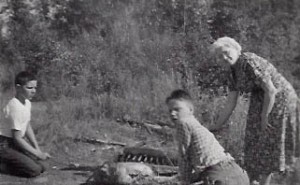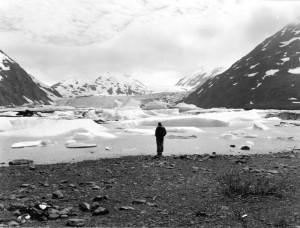In the early 1950s, many people thought Alaska was remote, practically inaccessible. My grandparents were not among them.
During WWII, their son, my father, was stationed with the Army Air Corps as a test pilot at Ladd Field near Fairbanks. He loved Alaska and vowed to return with his family to make it their home after the war. I was seven years old the summer of 1951 when he quit his job as a Northwest Airlines pilot and moved our family from Seattle to Anchorage to begin flying for Pacific Northern Airlines.

The first summer in Anchorage, we all pitched in to help Dad and friends build our two-story house. The second summer it still sported Fir-Tex siding and had no door on the lone bathroom. The good news is the plumbing was now indoors although it was still a few years before the sanitary outhouse conversion to a smokehouse was complete.
The next summer I was nine when my grandparents brought my cousin Tom with them and drove their new 1953 Ford on a five day journey up the Alcan Highway from Missoula, Montana. They arrived after dinner one evening, in high spirits, not concerned about the thick dust and excited that the car escaped any dents or dings from rocks along the way.
The moment the car stopped at the end of our driveway and Grandpa emerged from the driver’s side door, I launched myself at him, reveling in the comfort of his red and black checked Pendelton shirt that smelled of the Black Jack gum he always carried in his pocket next to the Tums. Toothpicks would be in the other pocket. Grandma wore a blue flowered dress as she hurried around to enfold me in a cheerful hug of her own. I don’t remember ever seeing her in anything but a dress.
Tom burst out of the car’s back seat, gave quick hugs all around before racing for the doorless bathroom. He was eight years old, the same age as my brother Bill who tried to look happy to see his grandparents as he waited impatiently for his cousin to reappear.
“We only had one flat the entire trip!” exclaimed Grandpa, “and that was in Dawson, so we didn’t have any trouble getting it fixed.” My grandpa was a cautious man and didn’t have to explain that he topped off the gas tank at every opportunity, eliminating concerns about running out of gas.
My three-year-old sister Bonnie eagerly accepted hugs and let Grandpa carry her into the house while Mom showed him and Grandma their room.
“Where are the window covers?” asked Grandma. “I’ll never be able to sleep with all this light.” Realizing she meant the extended daylight of our Anchorage summer, Mom pulled a green wool army blanket from the closet and then found a hammer and nails. She nailed the blanket to the top of the window frame before producing a piece of rope to tie it back in the morning. Being proactive, she didn’t wait to be asked before bringing out another blanket to hang from the bathroom door frame.
We kids were sent to bed shortly afterward. I can only guess that the adults weren’t too far behind, especially my grandparents after their long drive.
The next morning, I was excited about our breakfast of bacon, eggs, and toast. Bill and Tom also ate eagerly. Mom talked often over later years about how she could never quite forgive Grandma that morning for saying she disliked the taste of our “cold storage” eggs since she was used to fresh eggs from her own chickens and ducks. I never understood Mom’s ongoing anger about that.
Grandpa and Grandma would only be with us four days before heading back down the Alcan, so after breakfast Mom packed a picnic lunch and we all piled into the big, old, dark green GMC. With Dad at the wheel, we lumbered down the Seward Highway that had been completed slightly less than two years earlier. We wound along Turnagain Arm for at least an hour with the sheer rock, nauseating to look at directly, rising to our left and the expansive waters of the Arm on our right. As we rounded the end of Turnagain Arm, Dad said, “There’s a glacier in here, about a half-mile back. I’ve seen it from the air on my flights to Kenai. Would you like to see it? We could hike in.”

“Sure,” said Grandpa.
“Yes,” said Grandma.
“Let’s go!” shouted Bill and Tom together, jumping up and down on the back seat.
Dad pulled to the right shoulder of the Highway and stopped near the little town of Portage, at that time a community of less than 100 residents. A little more than a decade later, the 1964 Good Friday earthquake caused the shoreline to drop 6 feet or more allowing high tides to flood the town and surrounding area with salt water. All that remains today of the original village are a few structures sinking into the nearby mud flats and scattered stands of ghostly looking, dead trees, all of which can be easily seen from the Seward Highway.
As we began crawling out of the GMC behemoth, I wondered how my grandmother could feel comfortable in today’s dress, another flowered one, although faded and old since this was a casual trip. She also had on heavy nylons and the thick European-looking sandals she always wore. Grandpa had on another Pendelton shirt, green today and hopefully with more Black Jack in one pocket, heavy canvas-looking pants, and sturdy shoes. The rest of us wore jeans, cotton shirts, sturdy leather shoes and thick socks. We each had a jacket to protect against cool breezes that always seemed to blow across the frigid Arm waters.
Mom carried the green canvas knapsack with our picnic lunch as we crossed the highway and headed off through the thick brush of willows and alders, creating our own trail in sight of a little stream that flowed toward the Arm. Dad said the stream was probably runoff from the glacier we were all eager to see.
I felt a touch of anxiety as I remembered another glacier the summer before. We found it right next to a road that may have been a side road from the Richardson Highway, far east of where we were now. Dad had parked beside the road at the base of that glacier. Mom and Bonnie waited in the car while Dad took me and Bill by our hands as we gingerly walked up the icy slope onto the glacier. Suddenly, looking into a beautiful blue crevasse, we heard a thunderous CRACK! Dad leapt off that glacier like a startled deer with Bill and me holding tight to his hands, literally airborne.
Today we walked on the uneven ground, hard with various sizes of smooth granite rocks, no doubt rounded by the receding glacier. For what seemed like hours we walked over downed trees, lifting bleached and dead branches out of our way. A moderate breeze kept the pesky mosquitoes at a distance, so we didn’t have to douse ourselves in that horrid 6-12 repellent. Bill and Tom ran in and out of the bushes, peering back at us when Grandma or Mom cautioned them to stay close. We talked loudly to keep the bears away, although between the boys’ shrieks and hollers and Mom and Grandma calling them back it probably wasn’t necessary.
“I’m sure we’ve gone more than a half mile,” Dad said finally, more and more puzzled that we didn’t see any sign of a glacier. He and Grandpa took turns carrying Bonnie when she tired of navigating the heavy underbrush and uneven ground. Finally, to my relief, Bonnie began to whine about being hungry. I felt famished myself and, as the oldest child, knew better than to complain. That was a privilege reserved for company and the youngest children.
We found a level spot in a clearing near the stream that offered a wondrous view of the surrounding mountains. We set our jackets down to sit on while Mom began laying out our typical camping fare: cold Spam sandwiches on white bread with margarine. I’m gagging as I write it now – as I pretty much did then. Bonnie got a peanut butter and jelly sandwich and I wondered why we couldn’t all have that even though I preferred raspberry jam to the grape jelly mom liked to use on them. I was glad to see she had also packed potato chips, apples, and Fig Newtons, all of which we washed down with an orange-flavored juice drink. The adults enjoyed coffee poured into tin cups from a heavy metal thermos.
After lunch, Tom looked around and said, “Hey! Where’s Grandma?”
“Ssshh!” Mom hissed. “Give her some privacy.” Bill and Tom glanced at each other before racing off to throw stones into the stream.
“Joe, I think we should head back,” Mom said softly. “Your mother is getting tired.”
Dad looked at Grandma who sighed and nodded reluctantly. Dad agreed although he still wondered where he went wrong.
“I was sure we would find the glacier.” He sighed.
As we each gathered our belongings and packed up, the general mood was disappointment. We retraced our steps back to the GMC on the highway and tumbled in. It was very quiet in the car as Dad turned it around and began the long drive home along the winding two-lane Seward Highway.
“It’s a shame we didn’t find the glacier,” remarked Grandma at last.
“Yes,” said Grandpa, “it is. I guess we’ll just have to come back to Alaska another time.”
Ever since that day, when anyone wondered about a distance to some place, one of us would say, “Oh, it’s probably a half mile” and everyone would laugh. Around twenty years later, long after a paved road led to Portage Glacier, I remembered that story and realized that Portage Glacier was the one Dad had been looking for that day so long ago.
Out of curiosity, the next time I drove down there, I checked mileage from the Seward Highway turnoff to the glacier parking area to see how close we had been on our trek. The odometer said five miles! We may have walked more than half a mile that day and we were still not even close.
My grandparents drove the Alcan four more times over the next couple of decades. One trip they brought my Mom’s parents from Nebraska in addition to Tom again who moved his own family up many years later. Portage Glacier was always one of their requested places to visit.
MaryJo Comins lived in Anchorage from 1951 until 1995, graduated from AHS in 1961, attended the University of Montana, married and began raising a family before completing her BA in English with a sociology minor from the University of Alaska Anchorage in 1974.
She taught writing and creativity classes in Anchorage and Eugene, Oregon. Among her writing credits are the Anchorage Times, Anchorage Daily News, Alaska Magazine, Cruising World Magazine, and Alyeska Pipeline’s in-house magazine. MaryJo received writing awards from Alaska Press Women and an honorable mention from Writers Digest. She enjoys acting with community theater groups in Anchorage and now Eugene.




